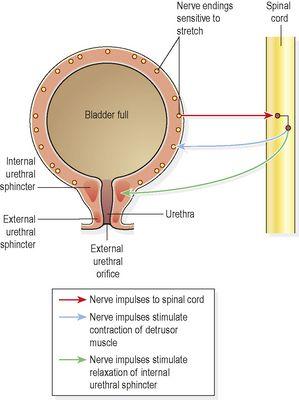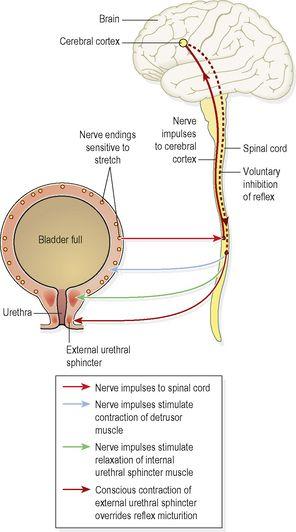Ross & Wilson Anatomy and Physiology in Health and Illness (162 page)
Read Ross & Wilson Anatomy and Physiology in Health and Illness Online
Authors: Anne Waugh,Allison Grant
Tags: #Medical, #Nursing, #General, #Anatomy

Learning outcome
After studying this section you should be able to:
compare and contrast the process of micturition in babies and adults.
When 300 to 400 ml of urine have accumulated in the bladder, afferent autonomic nerve fibres in the bladder wall sensitive to stretch are stimulated. In the infant this initiates a
spinal reflex
(see
p. 158
) and micturition occurs (
Fig. 13.22
). Urine passed in the response to parasympathetic stimulation of the bladder, causing contraction of the detrusor muscle and relaxation of the internal urethral sphincter. Urine is expelled from the bladder and passes through the urethra before leaving the body.
Figure 13.22
Reflex control of micturition when conscious effort cannot override the reflex action.
When the nervous system is fully developed, the micturition reflex is stimulated but sensory impulses also pass upwards to the brain and there is awareness of the need to pass urine. By learned and conscious effort, contraction of the external urethral sphincter and muscles of the pelvic floor can inhibit micturition until it is convenient to empty the bladder (
Fig. 13.23
).
Figure 13.23
Control of micturition after bladder control is established.
In adults, urine is passed when the detrusor muscle contracts, and there is reflex relaxation of the internal sphincter and voluntary relaxation of the external sphincter. It can be assisted by increasing the pressure within the pelvic cavity, achieved by lowering the diaphragm and contracting the abdominal muscles (Valsalva’s manoeuvre). Overdistension of the bladder is extremely painful, and when this stage is reached there is a tendency for involuntary relaxation of the external sphincter to occur allowing a small amount of urine to escape, provided there is no mechanical obstruction. Involuntary loss of urine is known as
incontinence.
Diseases of the kidneys
Learning outcomes
After studying this section you should be able to:
outline the principal effects of glomerulonephritis
describe the effects of diabetes mellitus and hypertension on kidney function
discuss the sources and consequences of kidney infections
explain the causes and implications of acute and chronic renal failure
describe the pathogenesis of kidney stones
list common congenital abnormalities of the kidneys
outline the development and spread of common kidney tumours.



